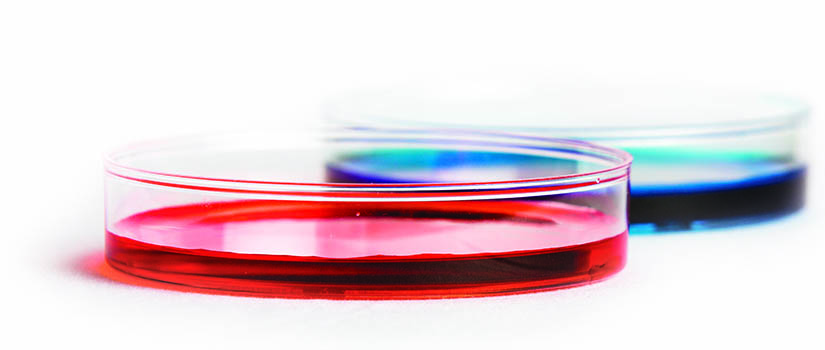Creating a protective armor that turns ordinary penicillin into a stealth fighter. Discovering what causes some antibiotics to turn the human immune system into a saboteur attacking the body’s own cells.
These are the promising advancements University of South Carolina researchers are making in the battle against drug-resistant bacteria.
“In the United States every year, around 100,000 patients die of bacteria-induced infections,” said Chuanbing Tang, a Carolina researcher and chemist. “And the problem is increasing because bacteria are building resistance. It’s a really, really big problem, not only for individual patients, but also for society.”
Reinvigorating the wonder drug
Without question, one of the greatest medical advancements of the past century is the ability to kill bacteria inside the human body. But now, nearly 100 years after the discovery of penicillin, the liberal — some would say overly lavish — use of these wonder drugs has led to the evolution of bacteria that are resistant to antibiotics.
Tang’s work looks at making existing antibiotics, like penicillin, more efficient against the defenses bacteria have developed over the years to combat them.
A particular portion of the molecular framework of many antibiotics — their three-dimensional geometry — wreaks havoc on the bacteria’s ability to reproduce. However, new strains of one particular bacterium, Staphylococcus aureus, can create an enzyme called beta-lactamase that breaks down this structure, rendering the numerous antibiotics whose effectiveness is based on it useless.
Tang has created a protective polymer — an armor if you will — that appears to make antibiotics less susceptible to bacteria’s defenses. It has even shown success against the bacterial strain known as MRSA, methicillin-resistant Staphylococcus aureus, a fearsome hospital-acquired infection that requires costly treatment. Tang’s polymer also seemed to help break apart the bacteria without damaging human red blood cells.
Therapeutic use of the polymer is probably years and many clinical test trials away, but Tang and his colleagues have taken a major step by reporting their findings in the Journal of the American Chemical Society in March 2014.
Breaking the code
The human body is filled with bacteria, some of which cause disease and illness and some that are necessary for the digestion of food.
These bacteria, good and bad, live as communities of cells called biofilms. The communities form protective shields through secretions from individual cells, and they trigger community responses through cell-to-cell communication. This communication also is a coded message that can alter a bacterium’s gene expression. Alan Decho wants to break that code.
“We are exploring a range of biological and chemical processes that occur within biofilms to understand how they function, and ultimately, how they may be manipulated or controlled,” Decho says. “It is those signals that trigger group responses that we are trying to control.”
Call it the power of working together. When bacteria “talk,” the biofilm community becomes more adaptable and resilient than individual bacteria cells. Decho says the creation of a biofilm also can lead to the bacteria being resistant to certain drugs.
The goal of his research is not to kill the bacteria, but to control its behavior. He is working with Brian Benicewicz, a polymer chemist at Carolina, to develop specialized nanoparticles to do just that. His is one of only about a dozen labs in the world engaged in this type of research.
First, do no harm
A leading cause of these new strains of bacteria is the indiscriminate use of antibiotics. Establishing better protocols for when to use particular types of antibiotic is Brandon Bookstaver’s mission.
A pharmacist, professor and researcher at the S.C. College of Pharmacy and School of Medicine, Bookstaver is helping pilot the use of rapid testing in hospital settings so doctors and pharmacists can build the appropriate weapon for fighting each infection.
“This can save 24 hours of giving the wrong drug,” Bookstaver says. “Rapid diagnostics have revolutionized how we manage these infections.”
The goal is to find the drug that will kill the disease-causing bacteria while doing as little damage as possible. In the worst cases, the destruction of helpful bacteria can allow a common colon bacteria, Clostridium difficile, to flourish. The extreme diarrhea and dehydration that ensues can be fatal.
“Your normal gut bacteria, or microbiome, is a wonderful thing, and one of the great things it does is prevent Clostridium difficile infections,” Bookstaver says. “It’s one of the worst consequences of an antibiotic, and it has become one of the most common hospital-acquired infections in the United States.”
Bookstaver’s team has created a database with five years of bacteria susceptibilities found at S.C. facilities.
The human touch
Just as these superbugs can develop a resistance to manmade antibiotics, they also can have a crippling effect on the body’s own defenses.
School of Medicine researcher Mitzi Nagarkatti is looking at how certain disease-fighting cells within the body produce toxins when confronted with certain strains of Staphylococcus. The resulting toxins these cells produce can lead to organ failure and death.
“You have to have an immune response to attack the microbes, but at the same time, there should be mechanisms to control it,” Nagarkatti says. “If this goes haywire, then you have damage.”
Nagarkatti, who is chair of the pathology, microbiology and immunology department, recently published a paper outlining early findings in studies of mice exposed through inhalation to the bacteria that causes food poisoning. The antibodies in one type of mice overreacted and began attacking lung cells. In the other type of mice, the disease-fighting cells were kept in check by an internally produced immunosuppressant.
“Following exposure to the microbes, the cells produce toxins that can activate some immune cells,” Nagarkatti says. “These are the cells that produce high levels of cytokines — small molecules — which can cause the deadly effects of exposure to this toxin.
“If we know what is responsible for the production of these cytokines, we can start to look at interventions,” she says.
